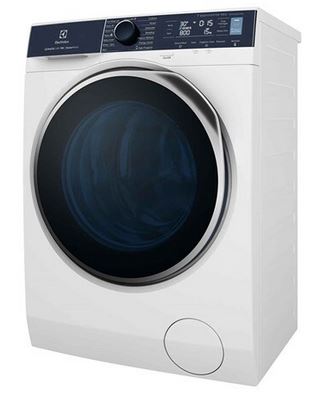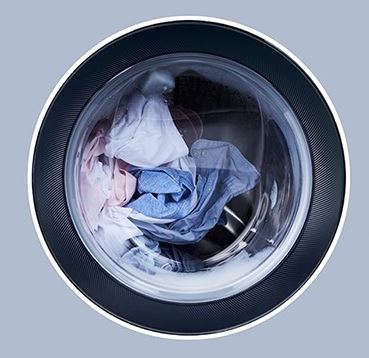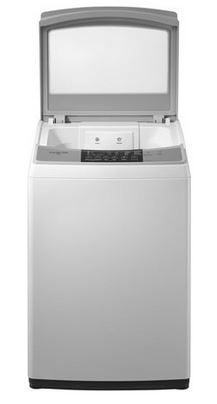An Electrolux washer sets the bar for cleaning efficiency and incredible wash cycles. But even so, sometimes you may have your Electrolux washer not spinning clothes dry, and you just can’t put a finger on it.
Well, your Electrolux washer may fail to spin clothes dry due to an issue with the power supply, laundry loading, wash setting, washer’s leveling, drainage, detergent use, door latch, drive belt, or motor coupling.
Before you can put your soaking wet laundry in the dryer, you should first dig deeper into why your washer doesn’t spin the clothes dry, and that’s where this guide comes in.
We will discuss all the issues highlighted above and give the appropriate fix in each case. The better part is that you can fix all the problems yourself, thus saving yourself time and money.

Are you in a rush? Below is a table summary with the nine issues and the immediate fix to attempt.
Electrolux Washer Not Spinning Clothes Dry – Quick Troubleshooting Guide
| – | Likely Problem | Quick Fix |
| 1. | Power issue | In case of a power blackout, wait for power to be back. If you use an extension, connect your washer to the wall socket directly |
| 2. | Laundry load issue | Remove some clothes if there’s an overload, and add some few in case of an underload. Always ensure your washer is 3⁄4 full, and redistribute your laundry evenly in case of an imbalance |
| 3. | Wrong washer setting | Choose the spin speed setting equivalent to your laundry type and size |
| 4. | Unlevelled Washer | Move the washer to a more even ground. You can also use a sprint level to adjust its feet to the ground |
| 5. | Drainage issue | Ensure you unclog the filter, hose, or pump in case of clogging. If the hose is extended (beyond 8 feet long), use a sump pump to drain all excess water, and after that, fix the hose height accordingly |
| 6. | Wrong detergent usage | Use HE detergent and in the right amount |
| 7. | Defective door latch | If the door latch has physical signs of wear, replace it. Also, test the latches assembly, and if it lacks continuity, replace it |
| 8. | Faulty drive belt | Replace the drive belt if it’s damaged |
| 9. | Damaged motor coupling | Replace the motor coupling |
Why is My Electrolux Washer Not Spinning Clothes Dry?
One of the issues below is likely to stop your Electrolux washer from spin-drying clothes:
1. Power Issue
The first thing that comes to mind every time you find soaking wet laundry after a spin cycle ends is power. You should check if there’s power.
The bad news is that the cycle ends prematurely when a blackout happens while your washer is still running, resulting in soaking-wet laundry.
If there’s power, then it could be that you are using an extension cord. Sadly, the extension cord does not transmit enough electricity to the washer, which could be why you have dripping wet laundry.
Quick Fix
In case of a power blackout, you should wait for the power. If you are using an extension cord, it’s time to stop and plug your washer directly into the electric outlet/wall socket.
2. Laundry Loading Issue
If it’s not a power issue, the next thing to check out is the load. Sometimes, you want to wash all the dirty clothes, and you end up overloading the washer.
A washer overload makes it hard for the washer to spin dry the laundry as it does not create any space for the clothes to turn and dry.
If it’s not an overload, maybe it’s an underload. An underload causes the clothes to jump out of position during the spin cycle and could be why you have wet laundry.
Suppose it’s neither of the two. How about the load balance? If the load is out of balance, it leans on one side, making it hard for the washer to spin dry the clothes.
Quick Fix
Remove some clothes in case of an overload, and add a sheet or so in case of an underload. It’s also a good idea to follow the manufacturer’s specifications on capacity. Most say you should fill the washer ¾ full.
In case of a load imbalance, open the washer and redistribute the laundry evenly before pressing the start button.

3. Wrong Washer Setting
The setting you choose determines if the washer will get rid of the water from clothes or not. It’s also an important consideration to select the spin speed correctly.
Some settings in your Electrolux washer have slow or no spin speed. For example, the Hand Wash or Delicate settings cannot remove all the water, especially if you choose them when washing bulky items like sheets or bedding.
Quick Fix
Ensure you match the washer’s spin speed settings according to the laundry size and type.
4. Unleveled Washer
For excellent spinning and for your washer to get rid of all the excess water from your laundry, your washer should rest on flat ground.
If the washer is out of balance, one thing for sure is that it will struggle to spin, which you can tell if it produces loud noises when running. This could also damage internal components as the washer struggles to turn using much force.
Quick Fix
Move your washer to a flatter ground. If the ground is flat, ensure you adjust the washer feet using a spirit level and ensure they touch the ground.
5. Drainage Issue
Your washer drains severally in each wash cycle. However, there are times when this does not take place effectively.
If your washer fails to drain, your laundry will soak wet at the cycle’s end. The ugliest truth is that the clothes could soak in dirty water.
In case of a drainage issue, check out the following:
- Clogged drain filter – The first thing to do is to check the filter. The washer filter acts as a sieve for all the foreign objects we fail to check out, like keys, jewelry, coins, or any other metal object. When the filter is heavily clogged, wastewater won’t pass through it, which soaks your clothes after a spin cycle.
- Clogged drain hose – The hose takes the wastewater from the washer to the pump, which empties to the sewer line. If the hose has twists, kinks, or elbows or is clogged with dirt or debris, wastewater won’t pass through it, which explains why your laundry is dripping wet.
- Clogged drain pump – If the filter and the hose are okay, the drain pump is the next thing to check. The pump receives wastewater from the hose and passes it to the sewer line or graywater system. If the pump is clogged, it will cause water to draw back to the washer and soak dirty clothes.
- Extra-long drain hose – During installation, the drain hose should have a height of 8 feet. If the installation isn’t perfect, it will hinder water from flowing through it, causing backflows that wet your laundry.
Quick Fix
In case of clogging in the filter, hose, or pump, use the drain snake to unclog them. If the hose height is beyond 8 feet long, use a sump pump to drain all the excessive water. Also, ensure you observe the correct drain pipe height to avoid recurrence.
6. Wrong Detergent Usage
Detergent is vital in each wash cycle as it helps loosen dirt and makes your laundry spotless. However, not all detergents are washer-proven.
Using the wrong detergent and in the wrong amount causes excess suds formation, which makes your clothes retain moisture and could be why your laundry is soaking wet.
DIY Fix
Check your manufacturer’s specifications on the type of detergent you should use in your manual. If the manual is nowhere near, most manufacturers recommend using only high-efficiency (HE) detergents in the right amount.

7. Defective Door Latch
If you check all the above but still can’t pinpoint the issue, it’s time to check specific components, and you should start your search on the door latch.
The latch should engage properly for your washer to start the cycle and spin the laundry. If the latch isn’t engaging, maybe due to wear or damage, your washer spinning is stopped.
Quick Fix
Check the door latch for signs of wear and replace it if damaged. Also, since you are figuring out the latch, if it has no physical signs of wear, it’s time to check the door latch assembly, and a multimeter can be of great help. If anything in the assembly, like the switch, lacks continuity, replace it.
8. Faulty Drive Belt
The drive belt wraps the motor to the drum and helps in spinning the drum. Since it’s rubber, it’s prone to natural wear over prolonged usage.
When the belt is overly stretched or has physical signs of wear, it won’t turn the drum, which could be why your laundry is soaking wet.
The good news is that diagnosing a defective drive belt is easy. One, listen to the sound your washer makes when running. If it turns forcefully or loudly, the belt is in question. Two, you can physically examine the belt and check for signs of wear.
Quick Fix
Check the belt for wear or stretchiness. If damaged, replace it.
9. Damaged Motor Coupling
Like the belt, the motor coupling also naturally faces wear and tear. Motor coupling connects the transmission to the motor and helps the spin cycle. If it’s defective, it usually stops the spin cycle.
Quick Fix
Replace the motor coupling.
How to Reset Electrolux Washing Machine
If you find no fault or still can’t figure out the issue with your Electrolux washer, resetting the machine is a good idea. It’s advisable to reset the washer after a component change or power interruption, among other issues.
Unfortunately, there is no reset button on Electrolux washers. However, the reset is simple, and you only need to follow the easy steps below:
- Unplug your Electrolux washer power cable from the power
- Wait for a minute or two and reconnect the cable back
- Your washer should reset
Concluding Thought On Electrolux Washer Not Spinning Clothes Dry
Above is an elaborative guide on why your Electrolux washer isn’t spinning the clothes dry. It could be an issue with power, laundry loading, detergent usage, washer leveling, or drainage.
If not, it could be due to a defective component like the door latch and its assembly, the drive belt, or the motor coupling. Whatever the cause, you can troubleshoot it yourself as shared, and more importantly, learn to use your Electrolux washing machine better.
